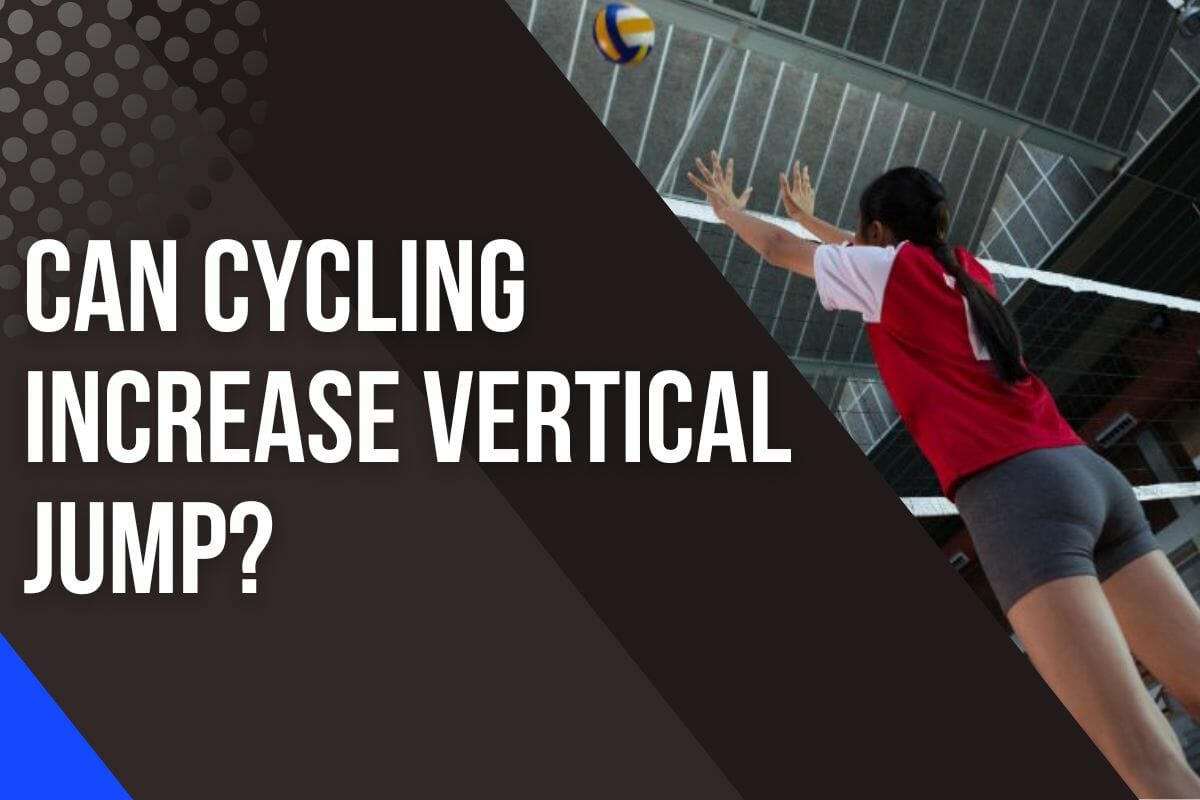Can Cycling Increase Vertical Jump?

Do you ever find yourself wishing that you could jump higher?
Basketball players, volleyball players, and other athletes might have the same thought in mind.
Surprisingly, cycling indirectly helps to increase your vertical jump.
With the right technique, cycling can help increase endurance and power while also helping develop coordination and balance – all of which are essential components of a successful vertical leap.
However, if you want to specifically train for the vertical jump, there are better exercises for that.
So, what is the right cycling technique to improve your vertical jump and what are these other exercises? Read on!
Does Cycling Really Improve Your Vertical Leap?
Studies have shown that cycling can improve muscle endurance, strength, and coordination – all key components of successful jumping power.

While it can certainly provide cardiovascular benefits that indirectly help with athletic performance, specific cycling techniques (explained in the next section) are needed to gain the most out of bike rides when it comes to increasing vertical jumps.
As the vertical jump requires explosive power from your lower body, tracking metrics such as distance, time, or calories burned does not optimize for this type of training.
The key to optimizing cycling for efficient vertical jump training is honing in on developing the total force output of your lower body.
This can be done by implementing higher rate intervals during which you extend your leg muscles and control the speed at which you coast downhills or rollers.

Extending through each pedal stroke will teach proper force absorption and execution, both of which are necessary for a successful vertical jump.
The time and frequency of intervals should be adjusted depending on age and skill level, but start slow and gradually increase peak forces over time.
Cycle The Right Way To Boost Your Vertical Jump
In order to maximize its potential for improving your jumping performance, it’s important to understand how exactly cycling helps with increasing your vertical leap.
If you’re really invested in boosting your vertical jump, saddle up and start training to give your legs the power they need to propel you higher.
The secret lies in understanding the various energy systems at your disposal. For longer rides, oxygen-dependent energy systems are needed.
However, for exercises like the vertical jump, ATP or Adenosine Triphosphate is the most effective form of energy.
It’s a quick and easy way to get an athletic performance boost, as it doesn’t require oxygen, but instead draws from stored energy sources in the body.
Imagine a sprint versus a marathon.
A 100 meters sprint requires ATP while a marathon requires an oxygen-dependent energy system.
To boost your vertical jump with cycling, sprinting is the way to go.
Push yourself as hard as you can for a short distance (like 100-200 meters) or a certain amount of time (like 10-15 seconds).

Make sure to include these sprints in the initial part of 1-2 of your weekly rides.
What if you are a beginner? No worries.
Make sure to build up your sprints gradually. Get at least a 3-minute rest between sprints to recover and maximize your power.
Too much too soon can be detrimental to your progress.
Take it slow and steady. As your stamina and endurance improve, you can add an extra weekly sprint.
Monitor your progress and adjust accordingly.
Better Exercises To Significantly Increase Your Vertical Jump
When it comes to performing efficient and effective vertical jumps, biking may help yet there are other exercises that yield much better results.
This isn’t surprising as athletes involved in basketball or volleyball rarely ever engage in cycling as a part of their training regimen.
If your goal is to specifically increase your vertical jumps, these 5 exercises are a better choice.
Squats and Glute Bridges
Squat jumps, glute bridges, and sumo squats build strength in the lower body muscles that help power your vertical leap. (1)
Incorporating these exercises into a regular training routine will help you maximize your vertical jump potential.
To perform a squat jump, start by standing with feet shoulder-width apart and toes slightly pointed outward.
Then, bend at the knees as if sitting back into an imaginary chair while keeping your chest up and core tight.
Once you reach the bottom of the squat position, explode upward off both legs and extend through the ankles while reaching your arms towards the sky.
Land softly on two feet then reset for another repetition.
Glute bridge variations are great for building single-leg strength, stability, and explosiveness.
Start by lying flat on your back with your feet planted firmly on the ground, hip-width apart, and close to your glutes.
Push through heels to lift hips off the ground until they form a straight line from shoulders to knees; don’t arch or hyperextend the spine during this movement as it can lead to pain or injury.
To make this move more challenging, raise one leg off the floor or hold weight across the lap/chest area before lifting hips up and down for reps.
Sumo squats are perfect for strengthening the inner thighs which help promote proper alignment when jumping vertically.
Similar to traditional squats, begin in an upright stance with wider than shoulder-width spacing between feet (toes should be pointing outwards).
Begin lowering yourself downwards like normal but keep feet stationary throughout the entire rep – instead of pushing up with heels, drive force through your inner thighs to come back up into a standing position!
Power Cleans / High Pulls
Cleans and high pulls are valuable vertical jump drills that can be used to increase an athlete’s explosive power.
Cleans involve explosively lifting the barbell from the floor to shoulder level, while high pulls involve explosively pulling a weighted object (e.g. kettlebell) up in front of your chest.
Both movements require great speed, coordination, and technical proficiency.
These exercises help develop a powerful hip extension, which is essential for maximizing vertical-jump performance.
Furthermore, they encourage athletes to actively engage their core muscles throughout the movement—this helps transfer force through all limbs, resulting in greater jumping ability.

Additionally, cleans and high pulls activate fast-twitch muscle fibers more than slow-twitch ones.
This increased recruitment further enhances the muscular strength and power output necessary for higher jumps.
By incorporating these two exercises into regular training routines, athletes can reap substantial improvements in their vertical leap capabilities.
The combination of cleans with other dynamic lower body exercises will create synergistic effects on overall athletic performance and jumping height.
Trap Bar Deadlifts
Now that you’ve mastered the cleans and high pulls, it’s time to move on to trap bar deadlifts.
This exercise is an excellent tool for developing strength, power, and stability in the lower body. (2)
Trap bar exercises are a great way to increase your vertical jump due to their explosive nature.
When performing this exercise, proper form is essential.
You want to ensure that you’re maintaining good posture throughout the movement and engaging your core muscles as well as your glutes, quads, and hamstrings.
A common mistake is bending at the hips too early.
Instead of letting gravity do its work by pulling your torso down towards the floor while keeping your back straight, make sure you keep tension in the upper body during the entire movement.
In regards to technique, focus on driving through your heels with each rep and staying balanced throughout the lift.

With every repetition try pushing into the ground with both feet evenly until you’re standing completely upright while still maintaining tension in your core and glutes.
The key here is control—you don’t want momentum taking over or else you risk injury!
Trap bar deadlifts require patience and practice but can be highly rewarding if done correctly.
As long as you pay attention to good form, use proper breathing techniques, and stay mindful of where your balance is coming from.
Depth Jumps
Depth jumps are an effective vertical jump training exercise that can help you significantly increase your jumping abilities.
The premise of this exercise is simple: drop from a box or platform and then immediately jump as high as possible once your feet hit the ground.
This helps develop power in your lower body muscles, eventually translating into increased vertical jump heights.
The key to properly performing depth jumps is to maintain good form while dropping off the box or platform and upon landing on the ground.
You should keep your head up and look straight ahead throughout the entire movement.
Furthermore, it’s important to land with bent knees for safety reasons and also so that you have enough spring in them to propel yourself upward when you leave the ground again.
In addition to working on strength, depth jumps will also improve coordination by teaching your body how to respond quickly after a sudden change in direction – like what happens during a dunk or lay-up attempt in basketball.
Sprints
Sprinting is an effective form of exercise for those looking to increase their vertical jump as it utilizes both strength and explosiveness when done correctly. (3)
Sprint training that focuses on improving vertical jump involves running up a hill or staircase at maximal effort with short rest periods between reps.
This is exactly what my volleyball coach trained me to do (when I was still playing volleyball).
The goal here is to push yourself as hard as possible in order to maximize your force production during each rep.

These types of sprints will not only help you become faster but also give you added benefits such as increased coordination and balance which will help you excel in any sport requiring quickness, explosiveness, and agility.
However, make sure you take adequate time for recovery in between workouts so that your body has proper time to heal and rebuild itself after intense sessions.
Final Thoughts
Cycling can indirectly help increase your vertical jump, only if done right.
To improve your vertical leap with cycling, make sure to include sprints into your biking routine.
In addition to cycling, there are other exercises that can help improve your vertical jumps such as weight training and plyometrics.
However, it’s important to consider any potential risks associated with these activities before engaging in them.





